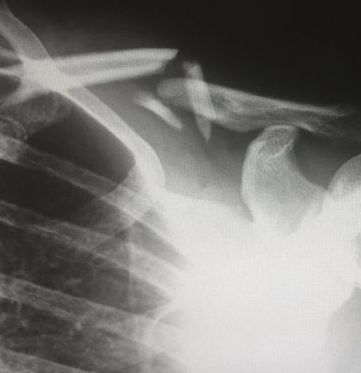
Fractures can occur during or after any kind of natural disaster, from a hurricane to an earthquake. Unexpected shaking around you can cause you to fall, and running to take cover can result in things falling on you. In the case of a terrorist attack, you may even be shot at. Anything is possible when the ground beneath you starts to move or there are strong winds blowing projectiles in all directions.
In this article we’ll look at how you can quickly treat a fracture. The goal here is to protect your limb. Ultimately, you must get to a hospital and get it treated. X-rays will need to be done to determine the fracture and place a cast.
The first aid techniques shown here is to be used to immobilize the affected limb so that pain is minimized, and any internal bone damage is not exacerbated.
Symptoms of a Fracture
The first thing you should be able to do is recognize the symptoms of a fracture. If you see that bone has penetrated or is protruding through the skin, it’s definitely a fracture. There may be other wounds close to the affected area.
If the victim heard his/her bones crack or they felt bone rubbing against bone internally during impact, there might be a fracture. Other signs are swelling, tingling, and numbness in the area. The pain of a fracture worsens over time. This is one of the surest signs of a fracture.
Treating Arm Fractures
Contrary to popular belief, not all arm fractures require you to place the arm in a sling. If the fracture is close to the elbow and the bone breaks in a way where bending the arm at the elbow causes more pain, you should avoid a sling.
Instead, place a towel between the arm and midsection of your body so that there is no gap between the arm and the body. You may use a belt or two bandages to tie around the arm and midsection. In this way, the arm will be immobilized and close to the body supported by the towel.
If it’s a simple fracture, you can use a triangular bandage to form a sling for the fractured arm and tie the ends behind your neck. Once again, tie a second bandage around the sling and your chest to immobilize the arm further. The aim here is to provide support and prevent excessive movement of the injured limb.
Treating Leg Fractures
Leg fractures are slightly more complicated. For a lower leg fracture, it’s best to ask the person to lie flat and feel the person’s affected foot to see if they can sense your touch.
Roll up a towel and place it between both legs, and then tie a bandage around the ankles with the towel sandwiched between. Tie a second bandage around both legs just below the knee. This will immobilize the legs and prevent the fractured limb from moving about.
In the event that there is a compound fracture and bone protrudes through the skin, the first step is to stop the bleeding. Apply hard pressure on the sides of the bone and skin to stop the bleeding. Don’t apply pressure on top of the bone and try to push it back in.
Once the bleeding stops, roll up some towels or padding and place them around the affected bone. In this way, you’re protecting the injured area with cushioning material. Roll up a towel and place it along the outer side of the leg. Place a wooden splint next to the towel and tie it all together with one bandage around the ankle and one around the thigh.
Using splints is required if medical help is out of reach. The splint on one leg will allow the victim to still move with a makeshift crutch until he/she gets to a place where they can call for help.
Remember the tips above and if you or anyone you know ever experiences a fracture, you’ll know what to do. Stay safe.

